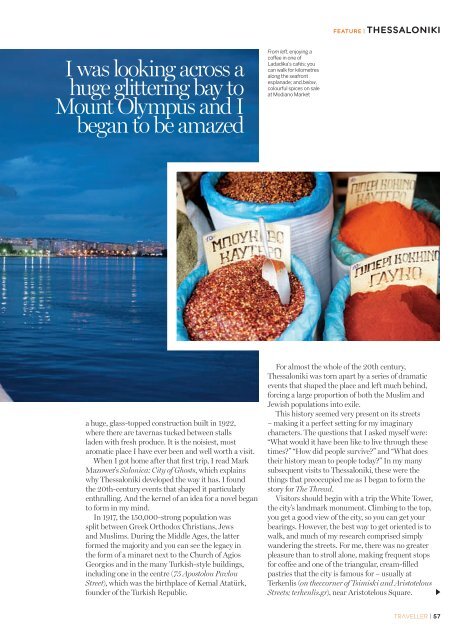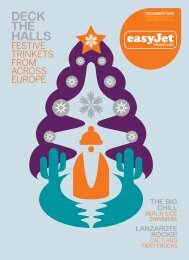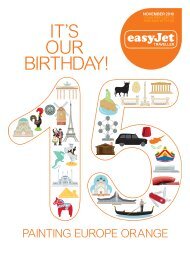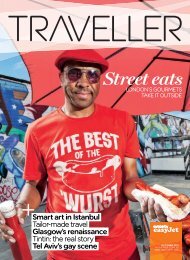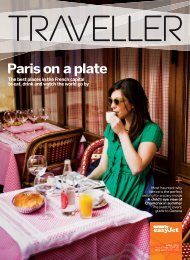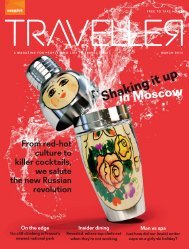You also want an ePaper? Increase the reach of your titles
YUMPU automatically turns print PDFs into web optimized ePapers that Google loves.
I was looking across a<br />
huge glittering bay to<br />
Mount Olympus and I<br />
began to be amazed<br />
a huge, glass-topped construction built in 1922,<br />
where there are tavernas tucked between stalls<br />
laden with fresh produce. It is the noisiest, most<br />
aromatic place I have ever been and well worth a visit.<br />
When I got home after that fi rst trip, I read Mark<br />
Mazower’s Salonica: City of Ghosts, which explains<br />
why Thessaloniki developed the way it has. I found<br />
the 20th-century events that shaped it particularly<br />
enthralling. And the kernel of an idea for a novel began<br />
to form in my mind.<br />
In 1917, the 150,000-strong population was<br />
split between Greek Orthodox Christians, Jews<br />
and Muslims. During the Middle Ages, the latter<br />
formed the majority and you can see the legacy in<br />
the form of a minaret next to the Church of Agios<br />
Georgios and in the many Turkish-style buildings,<br />
including one in the centre (75 Apostolou Pavlou<br />
Street), which was the birthplace of Kemal Atatürk,<br />
founder of the Turkish Republic.<br />
From left, enjoying a<br />
coff ee in one of<br />
Ladadika’s cafés; you<br />
can walk for kilometres<br />
along the seafront<br />
esplanade; and below,<br />
colourful spices on sale<br />
at Modiano Market<br />
FEATURE | THESSALONIKI<br />
For almost the whole of the 20th century,<br />
Thessaloniki was torn apart by a series of dramatic<br />
events that shaped the place and left much behind,<br />
forcing a large proportion of both the Muslim and<br />
Jewish populations into exile.<br />
This history seemed very present on its streets<br />
– making it a perfect setting for my imaginary<br />
characters. The questions that I asked myself were:<br />
“What would it have been like to live through these<br />
times?” “How did people survive?” and “What does<br />
their history mean to people today?” In my many<br />
subsequent visits to Thessaloniki, these were the<br />
things that preoccupied me as I began to form the<br />
story for The Thread.<br />
Visitors should begin with a trip the White Tower,<br />
the city’s landmark monument. Climbing to the top,<br />
you get a good view of the city, so you can get your<br />
bearings. However, the best way to get oriented is to<br />
walk, and much of my research comprised simply<br />
wandering the streets. For me, there was no greater<br />
pleasure than to stroll alone, making frequent stops<br />
for coffee and one of the triangular, cream-fi lled<br />
pastries that the city is famous for – usually at<br />
Terkenlis (on theccorner of Tsimiski and Aristotelous<br />
Streets; terkenlis.gr), near Aristotelous Square.<br />
TRAVELLER | 57


